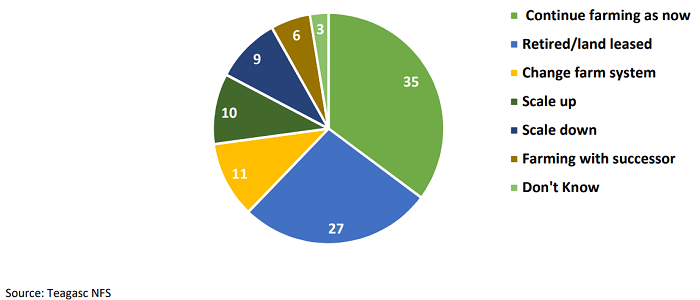21 May 2024
Future farming and succession plans on small farms

Along with examining the economic, environmental and social sustainability, the Teagasc National Farm Survey Small Farms Report 2022 provides some interesting insights in the future farming and succession plans of small farmers in Ireland.
Focusing on 48,000 farms with a standard output below €8,000, these farmers work about 15% of the agricultural area in Ireland. The average small farm has an area of about 13ha, with a typical herd size of about five suckler cows or 20 ewes.
Future farming plans
Given the proportion of small farms in Ireland and the evidential challenges around farm succession, farmer intentions around how they envisage the operation of their farm over the course of the next five years were investigated as part of the report.
Respondents were provided with a number of options to help indicate their expectations. More than one-third (35%) of small farm operators indicated that intend to continue farming. On the other hand, more than one-quarter (27%) expect to have retired and/or to have leased out their land. A further one-fifth (21%) intend to change farm system or scale up their farm business, whereas 9% are planning to scale back. A small proportion (6%) intend farming with a successor, with the remaining 3% unsure as to how the farm will develop over the next five years.
Figure 1: Future farm intentions in the next five years – Small Farm Survey 2022

Diversification options
When small farm operators were asked about their potential interest in a number of farm diversification options presented to them, some respondents indicated an interest in more than one option. In summary, just over half of respondents said that they would consider switching from their conventional farm system to organics. Similarly, 41% indicated that they would consider (further in some instances) participation in agri-environmental schemes. A smaller proportion of respondents suggested that they would consider the following options: a farm retirement scheme (17%), growing fodder for other farmers (13%) and forestry (13%). Very few respondents indicated an interest in contract rearing for other farmers (2%) or other on-farm diversification strategies (5%).
Farm succession on small farms
To assist in better understanding the process of farm succession on small farms, those farmers aged over 60 were asked about their planned intentions for the future of the farm. The survey found that 56% of small farm operators indicated that they had identified a successor. This figure is somewhat lower than that reported by NFS cattle and sheep farmers in a previous survey.
Figure 2: Farm succession plans – Small Farm Survey 2022

Among small farm operators who have not yet identified a successor (44%), some considered that it was too early to consider such a handover or the family were not interested in taking over the farm. Only 1% of respondents indicated that the farm would be sold.
On those small farms where a successor has been chosen, some insight in to their characteristics were gained. In terms of gender, 74% were male, 12% female with the remainder of farms being jointly passed on to both male and female successors.
Figure 3: Successor gender – Small Farm Survey 2022

Respondents were also asked if the successor (to their knowledge) had a third level qualification, with 36% stating that they had, 48% that they had not, with the remainder indicating that they did not know.
Figure 4: Successor third level qualification – Small Farm Survey 2022

Asked about the timeframe in which farm succession could be expected to take place, just under half (49%) of respondents considered that the transfer would take place in the next 5 to 10 years, 39% were unsure, 10% envisaged that the farm would be transferred over the course of the next 10 to 15 years, with only 3% expecting that the transfer would happen over the course of the next five years.
As per the future intentions of the successor, over one-third (36%) of small farm operators expected that the successor would change the farm’s system of production, with a further one-third expecting the successor to continue farming as is. Respondents expected that 22% of successors would not continue to farm with 10% unsure as to what the successor would do with the farm.
Somewhat surprisingly, when asked as to whether the move towards remote working would increase the likelihood of the farm continuing to be farmed in to the future, almost half (49%) felt that it would not, with a further 28% stating that it would and 24% unsure as to whether remote working would help facilitate the operation of the farm into the future.
This article was adapted from the National Farm Survey Small Farms Report 2022. The report was authored by Emma Dillon, Trevor Donnellan, Brian Moran, John Lennon and Cathal Buckley of the Teagasc Agricultural Economics and Farm Surveys Department.
Access the full publication here.
